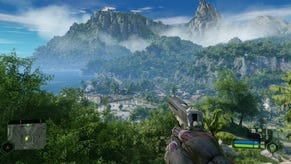Crysis Remastered: this is what ray tracing looks like on consoles
An impressive technical feat for Xbox One X and PS4 Pro.
The release of Crysis Remastered draws closer and today we can reveal a technical feature of the console versions that we simply didn't believe possible just a few short months ago - the implementation of real-time ray-traced reflections. In a console game? Really? You can cut to the chase by checking out the embedded video below to see this technology in action on Xbox One X, but the fact is that via clever optimisations, the software-driven RT found in Crytek's Neon Noir demo has been optimised for Microsoft and Sony's enhanced consoles - and it looks very, very impressive.
This continues a trend of Crytek delivering cutting-edge visual features to hardware that just doesn't seem capable of running them. For Crysis Remastered on Switch, Crytek and partner developer Saber Interactive impressed us by dramatically relighting the game using actual real-time global illumination via SVOGI - sparse voxel octree global illumination. In effect, SVOGI allowed surfaces to approximate the way light bounces, a form of ray tracing in itself... running on Switch! Crytek's software ray traced reflections work as an extension of that technology, covering specular reflections around the player view.
It's computationally expensive, limited in certain respects, but very definitely makes a positive impact to the overall presentation. Metal surfaces and glass produce accurate reflections - even on objects that are not present in screen-space. A very subtle but impressive effect is delivered via RT reflections that are mapped onto the nanosuit itself, as seen in the game's various cutscenes. Limitations? For a start, the technology is so GPU-intensive that it's only implemented on the enhanced consoles - PS4 Pro and Xbox One X. The vanilla variants of each machine are not invited to the RT party. Secondly, should you select the ray tracing option (there are performance and resolution/quality modes too), resolution is busted down to a dynamic 1080p.
The way that Crytek makes this possible on a console is an impressive feat - but it's one that requires some smart optimisations. For a start, ray traced structures around the player operate within a limited radius - and they're also rendered at a lower level of geometric precision. The reflections themselves are also rendered at quarter resolution, but the effect is of a higher fidelity thanks to an interlace-style effect, switching between two different 'fields' each frame (unnoticeable in the final presentation). No skinned objects like characters or deformable meshes are ray traced either - that's the domain of the hardware-accelerated form of ray tracing found on PC, which also supports Crytek's software RT as well for those with non-supported GPUs.
Looking at the console versions of Crysis Remastered, it's fascinating to see how the ray traced reflections integrate into the title's overall visual make-up because RT isn't the only way that this effect is rendered in the game. Where appropriate, standard screen-space reflections (SSR) make their way into the presentation, as do planar reflections - which effectively renders the scene twice. Both of these techniques are used for water reflections, for example, which do not feature ray tracing at all - another performance-saving measure.
Crytek is locking final features and polish for the launch of Crysis Remastered on September 16th and you can rest assured that we'll be looking at all console versions of the game closer to launch, with PC specialist Alex Battaglia running the rule over the PC game. However, suffice to say, we've been very impressed with what we've seen so far and can't wait to get to grips with final code.

















.png?width=291&height=164&fit=crop&quality=80&format=jpg&auto=webp)
